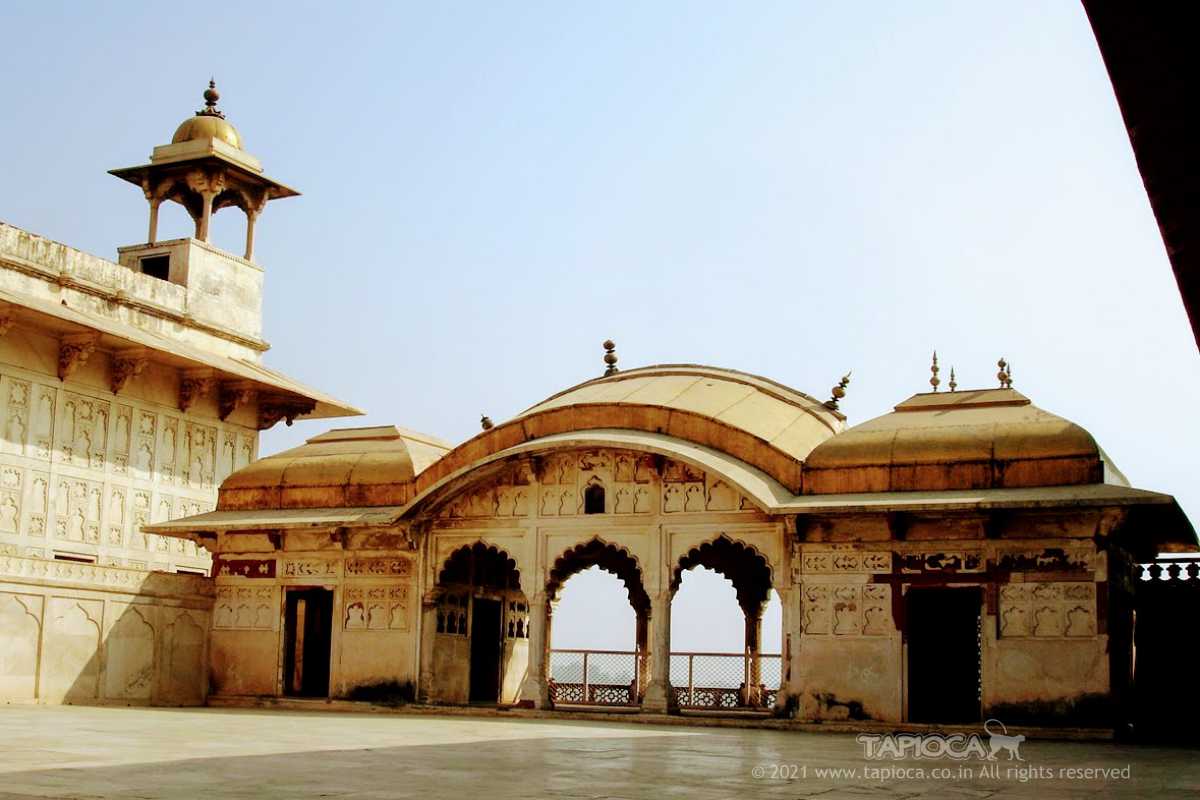Machhi Bhawan

I
nside the Agra Fort, right behind the Diwan-i-Am is the curiously named Machhi Bhawan ( the Fish Quarters!). The reason for this name probably we would not know, though one can guess that there was a fish pond of the like in the once ornate central courtyard.Machhi Bhawan resembles much like the Diwan-i-Am courtyard with the arcades surrounding it. But this courtyard is much smaller and the four sides of the arcades facing the court appears more like a private area of a palace. In fact it was. If Diwan-i-Am was were the king ( Jahangir ) conducted his public hearings , Machhi Bhawan was were he conducted the private discussions.
Though majestic in its outline , the details of Machhi Bhawan looks rather plane for a visitor. A few reasons are known and many remains mystery. After the fall of Agra Fort to the Jat kingdom in 1761 , this was the epicenter of a plunder and vandalism. What ever perceived as valuable and was rooted out and carted.
The fountains, fish tanks, florid marble beds ...all were carted to the palace of Suraj Mal, the Jat raja of Bharatpur.
The pavilion over the Jahangir's throne is non existing. Now the thrones stands on the open terrace exposed to sun and rain. This was probably one of the most exquisite part of the palace during its hay days.
After the Jats came the occupation of British East India Company. The vandalism continued for some more time. As a fund rising exercise one of its Governor Generals , Lord William Bentinck auctioned the marble panels and other fretwork decorated this part of the palace. He could not get the money he was expecting, so he abandoned the rest of his plans. According to his biography , that plan included auctioning the marbles of even Taj.
Then came a restoration efforts. That was under the direction of British during the later colonial period. The restoration could never bring back to the level of what the Mughal artisans achieved. In 1876 by Sir John Strachey, then Lieutenant-Governor of the North-West Provinces directed the some restoration of this area. A plaque was installed on the wall of corridor stating this. The Machhi Bhawan now looks as a simple living quarters with its plane plastered walls.
The Archeological Survey of India , under whose management is the fort's preservation now , has made the open inner court of Machhi Bhawan into a lawn. Two large arch ways give access to the court. The throne, which is at the third floor ( now on the open terrace) of the arcade overlooks the court. No more water fountains, no fish tanks and no frills , the Machhi Bhawan practically looks like a shadow of its erstwhile glandular.
On the terrace of Machhi Bhawan, in front of Diwan-i-Am stands two thrones. The white marble one faces the Machhi Bhawan court and the black one faces the riverside. Its called Takht-i-Jahangir (the throne of Jahangir). The black throne is more popular as a number of interesting stories and even some myths associated with it.
It is still debated who made this throne - Akbar or Jahangir.
The throne was made in 1602 that was about three years before Akbar's death and Jahangir's ascent as the next emperor. According to one version, it was made by Akbar for his son Salim ( who later known as Jahangir) to recognize him as the next emperor.
Another version of history is that it was made by Jahangir himself in defiance. The throne was made of black onyx imported from Belgium and kept ready in the Allahabad fort while Akbar was in power. In 1610, five years after the death of Akbar , the throne was brought to its present location in Agra fort.
The black throne sits close to the balustrade. It's possible to see both the riverside and the court itself sitting on this throne. In construction it is a 6 inch thick block of rectangular marble piece of about 10 feet length and 9 feed width. It stands on four hexagonal pedestals. The whole thing is installed on a white marble platform.
Though appears flat at fist sight the top surface of the throne is gently curvy. That is if water is poured on the middle it flows to the edges, thanks to its shell like profile.
The 6 inch thick edges are the most beautiful part of the throne. The story of the throne is carved around this edges in Persian. It praises Jahangir ( then Salim) as the Shah and Sultan. The cartouche that runs around the four edges are skillfully executed with floral motifs surrounding it.
Later in 1605 , when prince Salim ascended the Mughal throne , he added a few more inscriptions on the pedestal of the throne renaming himself as Nuruddin Muhammad Jahangir Badshah.
On the southern end of the throne is a fissure that runs along its full width. According to one version this was caused by a cannon ball hit during the 1803 siege by the British East India Company's army led by General Gerard Lake. The cannon fire got deflected after hitting the throne, damaging the wall near it.
The second version is a little more colorful and 4 decades older than the cannon hit story. Some times after the fall of Agra fort to the Jats, its king Jawahar Singh of Bharatpur tried to step on this throne. A fissure appeared with blood oozing out the throne. Shortly after the king got killed by one of his bodyguards during a hunting expedition.
"Chain of Justice" : It is often quoted as an example for the system of justice Jahangir administered. Now there is no bell or its artefacts to be seen here in Agra Fort. All what can be seen is the location roughly assumed to be were the chain and bells once stood. The idea was any ordinary subject with grievances could seek the kings attention directly. More likely it would have been installed as a deterrent or remainder to his own officers who are assigned with such responsibilities.
If there was a chain actually made , rather used , is not known. But according to descriptions given in his memoir - the Jahangirnama - the location of that chain was somewhere close to the octagonal tower facing the riverside , that is the Muasamman Burj . The chain attached to the bells stretched from here to the riverside for access.
In Jahangir's own words the details of his, " Chain of Justice" goes like this , "After my accession the first order I gave was for fastening up of the chain of justice, so that if those engaged in the administration of justice should delay or practice hypocrisy in the matter of those seeking justice, the oppressed might come to this chain and shake it so that its noise might attract attention.
Its fashion was this : I ordered them to make a chain of pure gold, 30 gaz (ie 27 meters or 90 feet approx. ) in length and containing 60 bells. Its weight was 4 Hindustani Maunds ( ie 150 kg or 33 lb approx.), equal to 42 Iraqi Maunds. One end of it they made fast to the battlements of the Shah Burj ( later replaced by Muasamman Burj ) of the fort at Agra and the other to a stone post fixed on the bank of the river "
